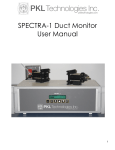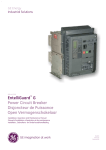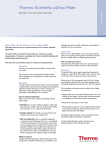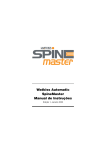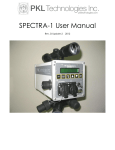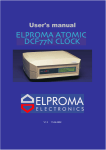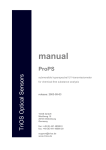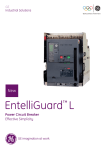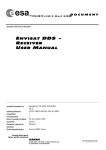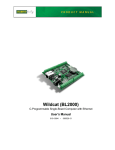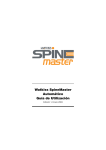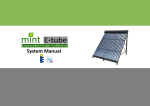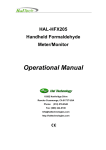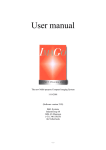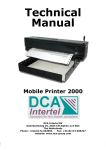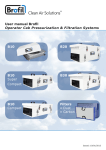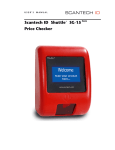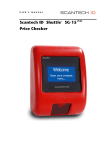Download Modbus TCP AUG 2012
Transcript
OPERATION MANUAL For GasFinder analyzers MODBUS TCP/IP MODULE For Partnumbers: BOR01725, Modbus TCP/IP Module with 1 Com Port BOR01730, Modbus TCP/IP Module with 2 Com Ports Boreal Europe BV Distributieweg 62 2645EJ Delfgauw The Netherlands www.boreal-laser.nl Boreal Europe BV, Thursday, August 23, 2012, Version 2 Boreal Europe B.V. Serial Modbus Module manual April 2012 CONTENTS 1. System Description ......................................................................................................................................... 1 2. Implementing the “polled” data in the DCS / Scada ....................................................................................... 1 3. 4. 5. 6. 7. 2.1. Modbus Registers .............................................................................................................................. 1 2.2. Concentration Data (IN PPMM) ........................................................................................................ 1 2.3. Concentration Quality (in R2) ............................................................................................................ 2 2.4. Light Value ......................................................................................................................................... 2 2.5. DAC Value (only If ALC is enabled, see also 2.4)................................................................................ 2 2.6. SECONDS (WATCHDOG!) ................................................................................................................... 2 2.7. Status Code ....................................................................................................................................... 2 2.8. Diagnostic Data ................................................................................................................................. 3 Dimensions and physical specifications .......................................................................................................... 4 3.1. CE compliance ................................................................................................................................... 4 3.2. Immunity ........................................................................................................................................... 4 3.3. Emission ............................................................................................................................................ 4 3.4. Labels................................................................................................................................................. 4 3.5. Safety concerns in ATEX area’s.......................................................................................................... 5 Pre-installation checks .................................................................................................................................... 6 4.1. Tools and equipment ............................................................................................................................. 6 4.2. Equipment check ................................................................................................................................... 6 Installation ...................................................................................................................................................... 7 5.1. Connecting the GasFinder RS232 Output .............................................................................................. 7 5.2. Connecting the Modbus master to the TCP/IP Network ....................................................................... 7 5.3. Connecting the power supply ................................................................................................................ 7 Setting up Communication parameters .......................................................................................................... 8 6.1. Input; Between GasFinder and Module................................................................................................. 8 6.2. Output; Between Modbus TCP/IP Module and the Modbus Master .................................................... 8 6.2.1. Configure the TCP/IP settings in the controller ................................................................................. 8 6.2.2. Using the IP changer Software .......................................................................................................... 9 6.2.3. Modbus registers ............................................................................................................................ 11 LED indication................................................................................................................................................ 12 7.1. A. ii LED Information explained .................................................................................................................. 12 Appendix ....................................................................................................................................................... 13 1. SYSTEM DESCRIPTION The Modbus TCP/IP Module is a small rackmount device allows the user to request the analyzer data from this device with the use of the Modbus TCP protocol. The user’s Master Modbus device can request all available data from the internal registers on a regular base depending on the situation. The Module converts the standard serial data strings from a GasFinder into Modbus registers. The Module analyses the strings sent by the GasFinder and stores the individual data in separate registers. The Modbus TCP/IP Module has standard 2 COM ports each for a GasFinder analyzer or other accepted instruments. Both comports are using the RS232 interface, enabling the Module to use a cable length of maximum 10 meter. The ports are capable of storing the sent values of two GasFinders simultaneously. The Module is using the RJ45 UTP interface, enabling the Module to use the Modbus protocol over an standard UTP network. 2. IMPLEMENTING THE “POLLED” DATA IN THE DCS / SCADA The data obtained by the ModBus Master, the users OPC server or DCS system has to be handled correctly. Most applications have their own needs and the implementation needs dedicated engineering. However, we hereunder give a guide how to implement the data within the DCS to obtain the maximum up time, minimize service and have the proper warnings and alarms. Note: For each connected channel the data is update in the registers when the GasFinder sends new data. Depending on the setting this can vary. Each channel is, with factory settings, in sequence updated in every 1.2 second. 2.1. MODBUS REGISTERS The data from the connected GasFinder(s) is stored in the holding registers. These registers have an address range of 40001 to 50000. Depending on which Modbus master software is used to read the holding registers of the Modbus controller the registers addresses have to be written differently (consult the user manual of the Modbus master software for the correct notation of the Modbus addresses). The values of the GFDTA, GFDBG and GFDAC strings are stored in the Modbus registers. The controller supports the input of the GasFinder MC, FC, OP and AB. Each time the Modbus controller receives a new string from the connected GasFinder the Modbus registers are updated. The Tables containing the Modbus register location can be found in Appendix A. 2.2. CONCENTRATION DATA ( IN PPMM) The concentration data is divided over two registers. The “ppmm” gives the concentration without decimals. This is sufficient for most applications. Example: Open path detection with a 100m pathlength will give an average path concentration divided by 100 to get a path average ppm level. A 1ppmm reading gives a path average of 1/100=0.01ppm. If alarm levels are 2ppm the accuracy is more than sufficient. No need to poll the decimal register. Example: A stack Ductprobe detection with a 2m pathlenght will give an average path concentration divided by 1 to get a path average ppm level. A 1ppmm reading gives a path average of 1/2=0.5ppm accuracy and minimum detection limit. In this case the decimal is needed to increase the accuracy with 1 decimal to 0.05ppm. If needed the decimal value can only be obtained if the concentration is below 100 or 10ppmm. This depending on the accuracy needed at high levels. The Modbus Master can make the decision. Boreal Europe BV, Thursday, August 23, 2012, Version 2 Boreal Europe B.V. 2.3. Serial Modbus Module manual April 2012 CONCENTRATION QUALITY (IN R2) The concentration of the gas obtained by the analyser has a quality factor called R2. The R2 can be used to filter out low quality readings. Example: In a safety application the goal is to have an alarm when the concentration gets to a level that requires a warning or alarm to be set. Lower concentrations can be filtered out by simply setting a R2 filter on 50-80 (on the range to 0-100) Example: In an emission detection system even the lowest concentration and low quality readings are important. The R2 filter is not used. 2.4. LIGHT VALUE The functioning of a connected transmitter head or probe depends on the loop of energy. The loop starts with optical laser energy transported through a fiber to the probe. The probe aims the optical energy on the retroreflector (mirror). The energy mirrored is reflected back into the probe and is focused on a photodiode. This diode transforms the optical energy into electrical energy. This energy is transported back through the coaxial return cable to the analyser. The level of energy returned is specified as “light level”. This light level should always be between a value of 2000-12000. Example if automatic Light Control is enabled: The lightvalue is always adjusted thus gives no real information. The DAC value should be used. Example if automatic Light Control is disabled: The value should be used as an indication for pollution of the optic system and is an indication for service. the value drops more than 30%, for longer than 30 minutes, for a particular channel (probe) preventive maintenance must be initiated. It can be planned in advance. Normally within 1-2 weeks is sufficient. 2.5. DAC VALUE (ONLY IF ALC IS ENABLED, SEE ALSO 2.4) The lightlevel can be automatically controlled (read; amplified and attenuated) by the analyser. However, when this is automated, by enabling the automatic light level option, the level stays corrected to the set level by the system. The correction is given by the DAC value. If the DAC value increases the probe needs more energy. This can be caused by higher humidity, steam, smoke or other influences in the “optical measurement path”. However it is also a good indication of pollution of the optics (The loop of energy!). When the DAC reaches the limit of 4095 the lightlevel will drop and cause low light errors. Example: When the DAC reaches 3000, for longer than 30 minutes, for a particular channel (probe) preventive maintenance must be initiated. It can be planned in advance. Normally within 1-2 weeks is sufficient. 2.6. SECONDS (WATCHDOG!) The second’s registers do function as a watchdog. In the case that something in the loop is “frozen” or stuck the seconds will not change. If the value of the seconds doesn’t change at every request of the Modbus Master a warning should be generated and the analyser must be inspected immediately. Data in the registers are not longer updated and are no longer actual! 2.7. STATUS CODE The Status Code gives all the accumulated errors within the analyser. The system has also a code when it is functioning properly. The code is either 1* or 9*. When the code is different than these all concentration data must be ignored for use as an alarm, warning or registration of the emission. Status code changes when servicing the analyser. However, when it changes during operation for A LONGER PERIOD THEN 5 MINUTES (and the system doesn’t give a normal status code after a stop/start) a Boreal Laser representative should be contacted! 2 Boreal Europe B.V. Serial Modbus Module manual April 2012 Example: The concentration is 546ppmm and this would generate an alarm. But the status code is 2048. Thus the reading must be ignored. Only the combination with a status code of 1* or 9* is a valid combination. 2.8. DIAGNOSTIC DATA Diagnostic data is available for each analyser. Requesting this data on a hourly base enhances the reliability of the system and minimizes the downtime. Values outside the accepted ranges require a service call by the nearest Boreal Laser Specialist. Historic data of these values can be send by email to help diagnose of the failure go faster. 1. Internal temperature Range 10-50 is accepted. 2. Duty Cycle Range between 100 – 200 is accepted. 3. Calibration Ratio Range of 4000 – 150000 is accepted. 4. Reference Cell Quality Range of 40-100 is accepted. 3 Boreal Europe B.V. Serial Modbus Module manual April 2012 3. DIMENSIONS AND PHYSICAL SPECIFICATIONS Weight (Grams) Dimensions (L x W x H) Humidity Power requirements Operation temperature range Store rate (maximal) Data output 3.1. 7.4 K g 38 x 48.5 x 10 cm 5–95%, non-condensing 100-240 VAC, 50Hz. –40°C to +70°C 2 samples / sec / each port RJ45, Modbus RTU over TCP CE COMPLIANCE Equipment is usually divided into two classes. Class A Digital equipment meant for light industrial use Less restrictive emission requirement: less than 40dB μV/m at 10m (40dB relative to 1 μV/m) or 300 μV/m Class B Digital equipment meant for home use More restrictive emission requirements: 30dB μV/m at 10m or 100 μV/m These limits apply over the range of 30–230 MHz. The limits are 7 dB higher for frequencies above 230 MHz. Although the test range goes to 1 GHz, the emissions from the Modbus TCP/IP Module systems at frequencies above 300 MHz are generally well below background noise levels. The Modbus TCP/IP Module is CE compliant and therefore has the CE Mark. 3.2. IMMUNITY The Modbus TCP/IP Module meets the following EN55024/1998 immunity standards. - EN61000-4-3 (Radiated Immunity) EN61000-4-4 (EFT) EN61000-4-6 (Conducted immunity) 3.3. EMISSION The Modbus TCP/IP Module meets the following emission standards. - EN55022:1998 Class B FCC Part 15 Class B 3.4. 4 LABELS FIGUUR 1 Boreal Europe B.V. Serial Modbus Module manual April 2012 FIGURE 2 Identification Sticker (Do not remove!!) 3.5. SAFETY CONCERNS IN ATEX AREA’S The Modbus TCP/IP Module is not intrinsically safe and therefore is normally installed in a “safe area” cabinet near the GasFinder analyzer. All outputs are not intrinsically safe and need additional safety devices according to the applicable ATEX standards. 5 Boreal Europe B.V. Serial Modbus Module manual April 2012 4. PRE-INSTALLATION CHECKS Check the following points: - Temperature limits; the Modbus TCP/IP Module should be located in an area where the temperature does not go below –40°C or above +70°C. Power supply; the Modbus TCP/IP Module needs power, Voltage: 100 V to 240 VAC, 50Hz, 0.375 A max. Accessibility; Acvces to the rear of the Modbus TCP/IP Module should be possible. Ventilation; Although the Module is highly efficient and generates minimum heat it needs some ventilation to cool down the inner parts. Therefore a space around the unit of 50mm at the front, back and sides are obliged. It can be horizontally stacked without space between other Boreal GasFinderMC modules. 4.1. TOOLS AND EQUIPMENT - Site specific personal protective equipment according to the local requirements. Set of assorted cable ties if cabling fixing is required. Set of screwdrivers. 4.2. EQUIPMENT CHECK Verify that all the equipment on the order sheet has arrived complete and is in good condition. Any damage due to shipping should be reported immediately and steps taken to obtain replacement parts. Damaged Modules should be replaced immediately and are not allowed to be installed. 6 Boreal Europe B.V. Serial Modbus Module manual April 2012 5. INSTALLATION Note: Make sure that during the entire installation process that the TCP/IP Modbus Module is not connected to any kind of power supply. 5.1. CONNECTING THE GASFINDER RS232 OUTPUT Note: make sure the Serial communication cable is not connected to the GasFinder before connecting it to the Module There are one or two serial COM ports located on the module depending on the version. COM 1 and an additional COM 2 can be found on the backpanel on the right hand side. A straight Dsub15 Cable is needed to connect the GasFinder analyser to the Modbus TCP/IP module. PIN Table Serial COM port pin name TX COM 1 RX COM 1 Ground COM 1 TX COM 2 RX COM 2 Ground COM 2 COM Port pin number 3 2 5 3 2 5 Figure 6 illustrates the correct way to connect the Modbus TCP/IP Module to one or two GasFinders. Depending on your model it has either 1 COM port or 2 COM ports. FIGUUR 6 5.2. CONNECTING THE MODBUS MASTER TO THE TCP/IP NETWORK There is one RJ45 port using the Modbus TCP interface, which is needed for the TCP/IP network communication to the Modbus Master / DCS. This port is located in the middle at the back of the module. (Figure 6) To connect the Modbus Master to the Modbus TCP/IP Module, the Module must be connected to the same TCP/IP network (subnet) as the Modbus master. 5.3. CONNECTING THE POWER SUPPLY Note: make sure that the power supply cable is not connected to any power source. The Module can be connected to a power source through a Standard Power Cord (shown on figure 6). The power supply must provide 100 V to 240 V AC. Voltages outside that range could damage the Module. 7 Boreal Europe B.V. Serial Modbus Module manual April 2012 6. SETTING UP COMMUNICATION PARAMETERS 6.1. INPUT; BETWEEN GASFINDER AND MODULE The communication between the GasFinder and the Modbus TCP/IP Module is done through the RS323 interface. In the following table the communication settings are described. These are standard settings in a GasFinder analyser. Baud Rate 9600 bps Parity None Bits 8 Stop Bits 1 Handshaking None It is important that the GasFinder is setup with these specifications, if it is not th e communication will fail and no data will be stored in the Modbus registers. 6.2. OUTPUT; BETWEEN MODBUS TCP/IP MODULE AND THE MODBUS MASTER Communication is only possible with a Modbus master if the IP address, gateway and network mask are correct. However, normally the settings have to be changed to adapt to a existing network. If the Modbus master is on a different subnet also a gateway must be set correctly to route the data to the other subnet. Most of the times this is the IP-address of the interconnecting switch or router. The Modbus TCP/IP Module is factory programmed with the following network settings: IP address: Network Mask: Gateway: Modbus Port 192.168.66.201 255.255.255.0 192.168.66.19 502 6.2.1. CONFIGURE THE TCP/IP SETTINGS IN THE CONTROLLER You can program the correct network settings yourself using dedicated software called “IPchanger” that can be downloaded from www.boreal-laser.nl/downloads/. For this you need the standard 9-15p GasFinder data cable with the RX/TX connected. (Part# BOR06100, production# 3120000 and higher) to connect to a PC with windows and a standard (9p) comport. (Older cables do only receive and have no possibility to send thus can’t be used as a programming cable.) If the network is build from different subnets the routers or switches must accept the Modbus protocol that is standard over port 502. Do request information at your IT department about the possibilities and possible change of settings of the local hardware. Normally these ports have to be opened since not used ports are normally closed. 8 Boreal Europe B.V. Serial Modbus Module manual April 2012 6.2.2. USING THE IP CHANGER SOFTWARE This software can only be used on a windows PC. Minimum requirement is windows XP and an available comport. If the PC/laptop has no com port you have to obtain a USB to serial converter. Doubleclick the icon and the next window will appear: Then chose an available comport. In this case we choose COM9 9 Boreal Europe B.V. Serial Modbus Module manual April 2012 Check the current IP settings by clicking on “fetch”. Write them down to be able to re-store the “old” settings. Then the next screen will appear. Fil in the desired network data in the fields and click on change. Be aware that you don’t use any ‘spaces’ while inserting the information. 10 Boreal Europe B.V. 6.2.3. Serial Modbus Module manual April 2012 MODBUS REGISTERS The data from the connected GasFinder(s) is stored in the holding registers. These registers have an address range of 40001 to 50000. Depending on which Modbus master software is used to read the holding registers of the Modbus TCP/IP Module the registers addresses have to be written differently (consult the user manual of the Modbus master software for the correct notation of the Modbus addresses). This is mainly due to the fact that some program start counting at ‘0’ and others start counting at ‘1’. Or some programs want the user to specify which type of register needs to be polled in the register number (4 is holding register and 3 is input register). This may give some problems trying to configure the Modbus master because the polled values will shift by one position. Here are some notations which in different programs give the same register, for this example register 1234 from the holding registers will be used: Register[1234] Register[1234] Register[1234] Register[1234] Modbus master A polling address(41234) Modbus master B polling address(401234) Modbus master A polling address(41235) Modbus master A polling address(1235) Because many programs use a different notation it is advised to check if the register values are correct before programming them into the Modbus Master. The values of the GFDTA, GFDBG and GFDAC strings are stored in the Modbus registers. The Module supports the input of the GasFinder MC, FC, OP and AB. Each time the Modbus TCP/IP Module receives a new string from the connected GasFinder the Modbus registers are updated. The Tables containing the Modbus register locations can be found in Appendix A. 11 Boreal Europe B.V. Serial Modbus Module manual April 2012 7. LED INDICATION There are two LED bars located on the front panel of the Modbus TCP/IP Module. The LEDs are used to indicate the general system status and the strings received from the connected GasFinder(s) and Modbus Master. The first array gives information about the string received on COM 1 and the second about the strings received on COM 2. Both arrays give information about the general status, strings received and commands received. The next tables provide the information about the LEDs. First LED Bar (COM 1) LED#, counting from left to right 1 2 3 4 Red LED (top) Wrong checksum Status code differs from *1 and *9 Buffer overflow (to many wrong NMEA strings are sent) Modbus timeout (Master has not polled for 2 minutes) Green LED Heart beat (blinks when a # of cycles has been completed) Modbus poll is being processed DTA string has been received on COM 1 DBG/DAC string has been received on COM 1 1 2 3 4 Red LED (top) Wrong checksum Status code differs from *1 and *9 Buffer overflow (to many wrong NMEA strings are sent) Modbus timeout (Master has not polled for 2 minutes) Green LED Heart beat (blinks when a # of cycles has been completed) Modbus poll is being processed DTA string has been received on COM 2 DBG/DAC string has been received on COM 2 Second LED Bar (COM 2) LED#, counting from left to right 7.1. LED INFORMATION EXPLAINED If the led 1 of the “wrong checksum” is blinking data is damaged. Slow down the measuring interval to see if this is the solution. If the error persists contact you “Boreal representative”. If the status code led blinks service is needed. In principle the Status code is not 1* or 9* If the Modbus Master doesn’t request data #4 will turn red. The connection is lost and the reason should be investigated. 12 Boreal Europe B.V. Serial Modbus Module manual April 2012 A. APPENDIX Standard Modbus Output Registers for GasFinder Analysers (BL2030) Mode: Slave,Binairy/RTU, Decimal Integers. Comport Out: RS485 1/9600/8/N/1 Channel 0 registers are used for GasFinder OP, FC and FCR Channel 1-8 registers are used for GasFinder MC systems that have 2 4 or 8 Channels Register assignments Input COM A (RS232): Channel 0 1 2 3 4 5 6 7 8 ppmm 41000 41001 41002 41003 41004 41005 41006 41007 41008 R2 41010 41011 41012 41013 41014 41015 41016 41017 41018 Status 41020 41021 41022 41023 41024 41025 41026 41027 41028 Light 41030 41031 41032 41033 41034 41035 41036 41037 41038 Seconds 41040 41041 41042 41043 41044 41045 41046 41047 41048 $GFDBG Int. Temp 41009 Duty Cycle 41019 Cal. Ratio 41029 Ref R2 41039 Ref Stat 41049 DAC 41050 41051 41052 41053 41054 41055 41056 41057 41058 Decimal Distance 41060 41070 41061 41071 41062 41072 41063 41073 41064 41074 41065 41075 41066 41076 41067 41077 41068 41078 DAC 42050 42051 42052 42053 42054 42055 42056 42057 42058 Decimal Distance 42060 42070 42061 42071 42062 42072 42063 42073 42064 42074 42065 42075 42066 42076 42067 42077 42068 42078 Register assignments Input COM B, (RS232): 13 Channel 0 1 2 3 4 5 6 7 8 ppmm 42000 42001 42002 42003 42004 42005 42006 42007 42008 R2 42010 42011 42012 42013 42014 42015 42016 42017 42018 Status 42020 42021 42022 42023 42024 42025 42026 42027 42028 Light 42030 42031 42032 42033 42034 42035 42036 42037 42038 Seconds 42040 42041 42042 42043 42044 42045 42046 42047 42048 $GFDBG Int. Temp 42009 Duty Cycle 42019 Cal. Ratio 42029 Ref R2 42039 Ref Stat 42049 Boreal Europe B.V. Serial Modbus Module manual April 2012 Example readings: Channel 1 2 3 t/m Ch 8 ppmm 0 15 35 45 R2 0 99 99 100 Status 1 2008 2001 9 Light 4029 3050 6500 5200 Seconds 15 12 56 15 $GFDB G Int. Temp 32 Duty Cycle 120 Cal. Ratio 10520 Ref R2 99 Ref Stat 0 DAC 2048 3258 4065 1556 Decimal 5 2 0 4 Distance 14 14 14 14 Ranges: Minimal Maximal Info ppmm 0 32000 Concentration of gas in ppmm R2 0 100 Quality of detection Status 0 32000 1 is normal status. Status code (hexadecimal) limited conversion. Light 0 32000 Between 2000 and 12000 Seconds 0 60 Check for " Alive data" DAC 0 32000 Light Amplification ( Standard=2048) Decimal 0 99 Decimal value of ppmm, if no value is present then value is 0 Distance 0 32000 Distance that the Gasfinder is set to Int Temp 0 100 Internal temperature in Celsius Duty Cycle 0 32000 Duty Cycle Cal Ratio 0 32000 Calibration ratio Ref R2 0 99 R2 from the Reference Cell (Quality) Ref Stat 0 32000 Reference Status Remark: These registers are the standard registers since February 7, 2012 for all Modbus controllers available. Older types might have different registers if you have a GasFinderOP or FC/FCR. Check your documents that were shipped with your controller at that time. 14
















